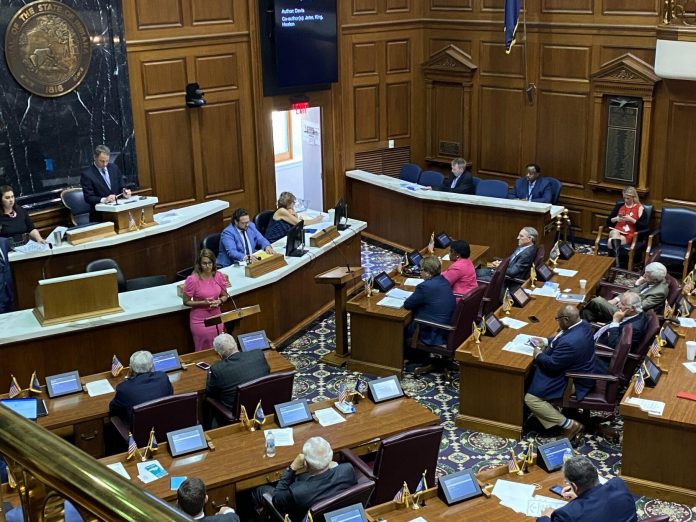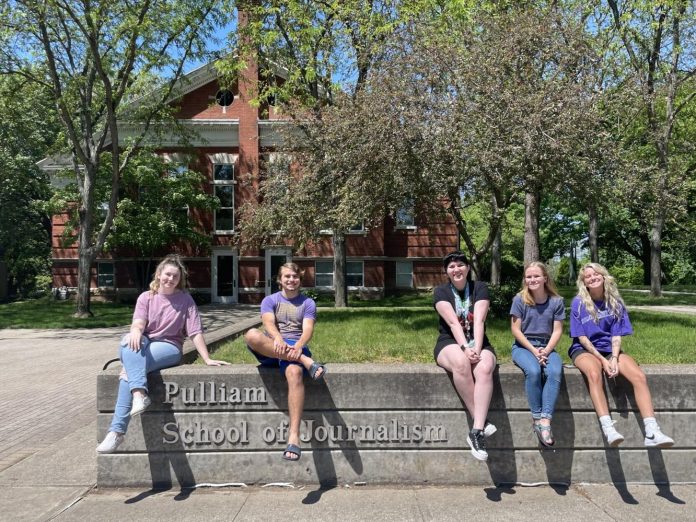UPDATE: Indiana General Assembly Overrides Holcomb’s Veto Of “Trans Athlete Bill”
Holcomb also pointed to the Indiana High School Athletic Association’s policy as proof that the legislation is unneeded.
The policy looks at cases on an individual basis, and IHSAA commissioner Paul Neidig said he only knows of two applications in the past 10 years. One was regarding a student who was transitioning to male and was allowed to compete on a male cross-country team. The other applicant, who was transitioning to female, decided against continuing to pursue the issue.
In both sessions, the governor’s veto was read aloud. Where they diverged was in what followed. While there was no debate in the House, the Senate spent over an hour talking about the bill.
Sen. Stacey Donato, R-Logansport, presented the bill and said it was important no matter if there were only one case. She also mentioned other states that have passed similar legislation.
Sen. J.D. Ford, D-Indianapolis, who spent much of his 30-minute-long speech speaking about Republicans like Holcomb and Utah Gov. Spencer Cox who oppose this and similar bills, responded to Donato by saying many of those laws are currently being challenged in courts.
Sen. Shelli Yoder, D-Bloomington, also spoke and asked if this was a worthy use of the Senate’s time.
“We are spending our time to make children feel bad about themselves,†Yoder said. “This bill is in no way a solution to a problem. It is a problem.â€
Before the sessions began, members of the public stood in lines outside the House and Senate chambers waiting to be admitted.
LaKimba DeSadier, state director of Planned Parenthood, said she was there to “hold our legislators accountable.â€
“We just want them to be accountable and truly represent their community,†DeSadier said.
John Lapp, who has a transgender child, said, “I feel very strongly that this is a hateful bill.â€
“Everyone’s a human,†said Natalie Auberry. “It goes against my values to discriminate like this.â€
She continued: “You know, I was very happy to see, personally, that there are more people here on this side of the issue than on the other side.â€
A recent survey by American Principles Project, a conservative think tank, suggests that when it comes to Hoosiers overall, they do support the bill.
In a survey of around 1,000 likely voters, 64.5% said they would “support legislation that banned biological male students that identify as transgender girls from competing in girls’ sports programs at Indiana K-12 public schools. Some 53% disapproved of Holcomb’s veto.
Seven Republicans split with their party to vote to uphold the veto. They were Rep. Ed Clere, R-New Albany; Rep. Tom Saunders, R-Lewisville; Rep. Cindy Ziemke, R-Batesville; Sen. Ron Alting, R-Lafayette; Sen. Phil Boots, R-Crawfordsville; Sen. Ed Charbonneau, R-Valparaiso; and Sen. Greg Walker, R-Columbus.
City-County Observer Footnote: Area Lawmakers who voted to override the governor’s veto to protect the integrity of the “Trans” Athlete Bill in Indiana were TIM O’BRIEN (R), WENDY MCNAMARA (R), MATT HOSTELLER (R), AND CINDY LEDBETTER (R). Â The lone area Democrat who voted not to overturn the Governor’s veto was RYAN HATFIELD (D).
At press time we had a problem verifying how Indiana State Senators Becker (R) and Toomes (R) voted on this issue but shall provide our readers an update once we find the results.
The City Of Evansville Department Of Parks And Recreation Released Finalized Designs For Sunset Skatepark.
The City Of Evansville Department Of Parks And Recreation Released Finalized Designs For Sunset Skatepark.
MAY 25, 2022
The new concept for the Riverfront park was developed by Hunger Skateparks and incorporates features requested during a March public input session. Updates include a refreshed design for the manual pad in the center of the rink, redesigned ledges to include out and ride-on options, an Amoeba Bowl, and a reconfigured bike zone.
“We’re proud of our local skate community for leading this effort,” said Mayor Lloyd Winnecke. “When completed, Evansville will be home to one of the largest and most diverse skateparks in our state.”
Hunger Skatepark designers added plans for rain gardens to mitigate stormwater runoff. The design team also ramped up appearances by pulling creative inspiration from the historic Mississippian culture that once thrived during 1000-1450 A.D. a few miles from the park’s location.
“Sunset Skatepark will be located between Mickey’s Kingdom and the Evansville Water & Sewer Utility Sunrise Pump Station,” said Deputy Mayor and interim Director of Parks & Recreation Department Steve Schaefer. “By this time next year, a section of our Riverfront will be completely transformed into a public space where residents can ride, play, relax and learn.”
Construction on the park will begin this fall.
FOOTNOTE: Follow the park project on the Sunset Skatepark Facebook page or at skatesunset.com.
Download the renderings: https://we.tl/t-fR2ive5lKP
Local Lawmakers Override Governors Veto “To Protect Girls’ Sports”

Local Lawmakers  Voted  To Override The Governors Veto to “Protect Girl Sports” In Indiana
MAY 25, 20022
Indiana State legislators voted on Tuesday to override the governor’s veto of House Enrolled Act 1041, which prohibits biological males from competing in K-12 girls’ sports in Indiana. The vote came as part of technical corrections day, where lawmakers can take up any vetoes and fix technical errors in laws passed during the prior session.
“Young women have fought hard for the same opportunities as men, and it’s only right to protect the integrity of girls’ sports in Indiana,” State Representative Bartels (R) said. “Overriding this veto was important so we can prevent unfair competition throughout our state.”Indiana will join at least 16 other states that have similar laws on the books protecting female sports. Lindauer said concerned parents reached out after an increasing number of biological males have dominated the national spotlight in girls’ athletic events across the nation.
“Female athletes work hard to win titles and earn scholarships, and shouldn’t watch from the sidelines because a biological male took their playing time,” State Representative Lindauer (R) said. “This is about fairness, and overriding the veto was the right thing to do.”
There are certain biological differences that give males an unfair advantage over females in sports, like greater muscle mass, bone density, and cardio capacity. Lindauer said the vote Tuesday was especially important as June marks the 50th anniversary of Title IX, which ensures women have an equal opportunity to play and compete in sports.
In Indiana, a gubernatorial veto can be overridden with a constitutional majority vote in both chambers, and the bill becomes a law without the governor’s signature. For more information about House Enrolled Act 1041, effective on July 1, 2022, visit iga.in.gov.
Area Lawmakers who voted to override the governor’s veto to protect the integrity of girl sports in Indiana were TIM O’BRIEN (R), WENDY MCNAMARA (R), MATT HOSTELLER (R), AND CINDY LEDBETTER (R). Â The lone area Democrat who voted not to overturn the Governor’s veto was RYAN HATFIELD (D).
FOOTNOTE: At press time we had a problem verifying how Indiana State Senators Becker (R) and Toomes (R) voted on this issue but shall provide our readers an update once we find the results.
We also find it interesting that our local lawmakers didn’t make any comments concerning their vote on this issue. We feel that it’s very important for the voters of this community to find out the rationale why our local representatives voted on this issue the way they did.Â
David Ragland Named Head Men’s Basketball Coach At UE
David Ragland Named Head Men’s Basketball Coach At UE
Evansville Native Brings A Wealth Of Experience To The Program
 EVANSVILLE, Ind. – David Ragland has been named the 16th head men’s basketball coach in University of Evansville history. The announcement of the 8th Division I head coach in Purple Ace’s history was made by Director of Athletics Dr. Kenneth “Ziggy†Siegfried.
Media is invited to meet with Coach Ragland and Ziggy Siegfried inside Meeks Family Fieldhouse between 2 p.m. and 3 p.m. CDT on Wednesday, May 25. Each station/publication will receive a 10-minute 1-on-1 opportunity with Ragland and Siegfried. Those who would like to reserve their time are asked to RSVP to Bob Pristash at rp113@evansville.edu.
At 6 p.m. on Wednesday, a community introduction will take place at Meeks Family Fieldhouse. The event will be open to the public. Media is invited to cover the event; however, interviews with Ragland and Siegfried must be conducted at the earlier media opportunity.
“As we moved through the search process for our new head men’s basketball coach, David Ragland separated himself from the other candidates and established himself as the clear choice to lead our program,†Siegfried said. “David brings a pedigree that will help our program in every way while his familiarity with the Evansville community will help to reengage our supporters.â€
In a coaching career that has spanned nearly two decades, Ragland’s experience has seen him contribute to an impressive group of programs that includes Butler, Utah State, Valparaiso, Vincennes, Northern Kentucky, Bowling Green, Indiana State, and Frank Phillips College. He joins the Evansville program following a 1-year stint as an assistant coach at Butler University.
Prior to his tenure with the Bulldogs, Ragland enjoyed a successful tenure at Utah State where his squads achieved at least 20 wins in each of his three seasons while finishing with an overall mark of 74-24. The Aggies made two NCAA Tournament appearances during his tenure while the 2019-20 squad posted a 26-8 mark before the postseason was canceled due to COVID-19.
“I want to thank Dr. Siegfried and President Pietruszkiewicz for putting their trust in me to lead this program. It is a dream come true to return home. Evansville is such a special place for my family and myself and the opportunity to come back to where it all started means the world,†Ragland exclaimed. “Growing up in the city, I understand what the Purple Aces program means to the community. From day one, I will work to establish a program that the entire University of Evansville campus community and the city of Evansville will be proud of. My family and I are excited to be home.â€
Ragland has worked at two current Missouri Valley Conference institutions, including a 2-year stint at Valparaiso. His first season with the program saw them accumulated 24 victories in 2016-17 while finishing with a Horizon League regular season championship and a spot in the postseason NIT. Highlighting the roster for VU was Horizon League Player of the Year Alec Peters, who was the 54thpick in the 2017 NBA Draft.
From 2010 through 2014, Ragland was an assistant coach at Indiana State where the Sycamores put forth one of the top stretches by a mid-major program in recent memory. ISU recorded 80 victories along with four postseason appearances, including a spot in the NCAA Tournament in 2010-11. Ragland was an assistant at Northern Kentucky (2015-16) and Bowling Green (2014-15) following his stint with the Sycamores. He contributed to a 24-11 mark at NKU, which included an NCAA Tournament berth.
His first head coaching opportunity came at Vincennes University where he led the Trailblazers to a 44-19 record in two years at the helm. The 2009-10 campaign saw them post a 22-10 mark and a run that took the program to the NJCAA District Tournament Finals. Ragland opened his coaching career at Frank Phillips College where he was part of a squad that went 25-5 in 2004-05.
Graduating from Harrison High School, Ragland was named an All-State Honorable Mention basketball player. He began his collegiate career at Missouri Southern State College in Joplin, where his team went on to the NCAA Division II Final Four during his freshman year. Following his sophomore year, he transferred to the University of Sothern Indiana where he played two seasons, propelling the Screaming Eagles to a total of 47 victories and leading the team in assists both years.
Ragland and his wife, Annie, have two children: Ava and Joshua.








 From left, Ashlyn Myers, Isaac Gleitz, Ari Lovitt, Taylor Wooten and Maddie Alexander pose outside Shirk Hall on the Franklin College campus, home to the Pulliam School of Journalism. The five reporters just finished a successful stint at
From left, Ashlyn Myers, Isaac Gleitz, Ari Lovitt, Taylor Wooten and Maddie Alexander pose outside Shirk Hall on the Franklin College campus, home to the Pulliam School of Journalism. The five reporters just finished a successful stint at 